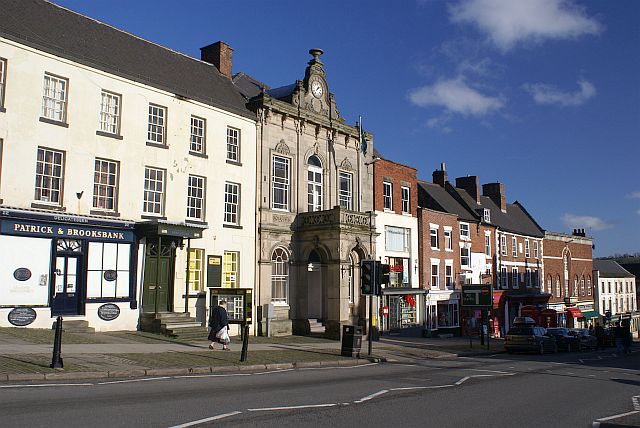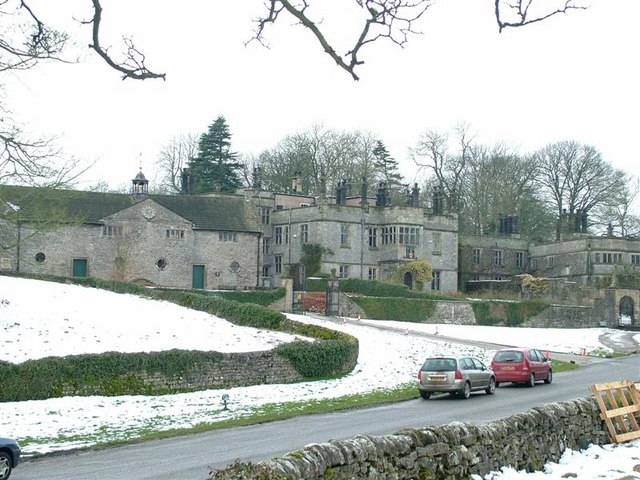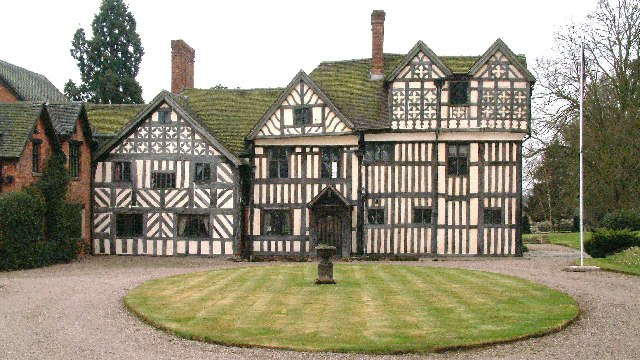|
Somersal Hall
Somersal Herbert Hall is a privately owned timber-framed 16th-century country house at Somersal Herbert, near Ashbourne, Derbyshire, in England. It is a Grade I listed building. The Fitzherbert family came to Somersal in the 13th century when the estate was acquired by Thomas Fitzherbert, second son of Sir William Fitzherbert of Norbury. The present timber-framed house was built by John Fitzherbert on the site of an earlier manor house in 1564. The entrance front at the south and other parts were encased in brick in 1712, when the property was enlarged. The Somersal line of the Fitzherbert family was extinct on the death of Richard Fitzherbert in 1803. The estate was initially sold in 1806 outside the family but was later repurchased by his cousin Alleyne Fitzherbert, 1st Baron St Helens, younger brother of Sir William Fitzherbert, Bt of Tissington. He lent it in 1808 for life to cousins of his, the novelist Frances Jacson (1754–1842) and her sister Maria Jacson (1755–1829 ... [...More Info...] [...Related Items...] OR: [Wikipedia] [Google] [Baidu] |
Timber Framing
Timber framing (german: Holzfachwerk) and "post-and-beam" construction are traditional methods of building with heavy timbers, creating structures using squared-off and carefully fitted and joined timbers with joints secured by large wooden pegs. If the structural frame of load-bearing timber is left exposed on the exterior of the building it may be referred to as half-timbered, and in many cases the infill between timbers will be used for decorative effect. The country most known for this kind of architecture is Germany, where timber-framed houses are spread all over the country. The method comes from working directly from logs and trees rather than pre-cut dimensional lumber. Hewing this with broadaxes, adzes, and draw knives and using hand-powered braces and augers (brace and bit) and other woodworking tools, artisans or framers could gradually assemble a building. Since this building method has been used for thousands of years in many parts of the world, many styles ... [...More Info...] [...Related Items...] OR: [Wikipedia] [Google] [Baidu] |
Somersal Herbert
Somersal Herbert is a hamlet and civil parish in Derbyshire, England, 2 miles northeast of Doveridge. Somersal Herbert Hall was built c.1564, incorporating an earlier building from c.1500, and is a Grade I listed building. Hill Somersal and Potter Somersal are minor settlements within 1 mile. See also *Listed buildings in Somersal Herbert Somersal Herbert is a civil parish in the Derbyshire Dales district of Derbyshire, England. The parish contains twelve Listed building#England and Wales, listed buildings that are recorded in the National Heritage List for England. Of these, on ... References Hamlets in Derbyshire Civil parishes in Derbyshire Derbyshire Dales {{Derbyshire-geo-stub ... [...More Info...] [...Related Items...] OR: [Wikipedia] [Google] [Baidu] |
Ashbourne, Derbyshire
Ashbourne is a market town in the Derbyshire Dales district in Derbyshire, England. Its population was measured at 8,377 in the 2011 census and was estimated to have grown to 9,163 by 2019. It has many historical buildings and independent shops. The town offers a historic annual Shrovetide football match. Its position near the southern edge of the Peak District makes it the closest town to Dovedale, to which Ashbourne is sometimes referred to as the gateway. The town is west of Derby, south-east of Buxton, east of Stoke-on-Trent, south-south-east of Manchester, south-west of Sheffield and north of Lichfield. Nearby towns include Matlock, Uttoxeter, Leek, Cheadle and Bakewell. History The town's name derives from the Old English ''æsc-burna'' meaning "stream with ash trees". Ashbourne was granted a market charter in 1257. In medieval times it was a frequent rest stop for pilgrims walking "St Non's Way" to the shrine of Saint Fremund at Dunstable in Bedfordshire. T ... [...More Info...] [...Related Items...] OR: [Wikipedia] [Google] [Baidu] |
Derbyshire
Derbyshire ( ) is a ceremonial county in the East Midlands, England. It includes much of the Peak District National Park, the southern end of the Pennine range of hills and part of the National Forest. It borders Greater Manchester to the north-west, West Yorkshire to the north, South Yorkshire to the north-east, Nottinghamshire to the east, Leicestershire to the south-east, Staffordshire to the west and south-west and Cheshire to the west. Kinder Scout, at , is the highest point and Trent Meadows, where the River Trent leaves Derbyshire, the lowest at . The north–south River Derwent is the longest river at . In 2003, the Ordnance Survey named Church Flatts Farm at Coton in the Elms, near Swadlincote, as Britain's furthest point from the sea. Derby is a unitary authority area, but remains part of the ceremonial county. The county was a lot larger than its present coverage, it once extended to the boundaries of the City of Sheffield district in South Yorkshire where it cov ... [...More Info...] [...Related Items...] OR: [Wikipedia] [Google] [Baidu] |
Grade I Listed Building
In the United Kingdom, a listed building or listed structure is one that has been placed on one of the four statutory lists maintained by Historic England in England, Historic Environment Scotland in Scotland, in Wales, and the Northern Ireland Environment Agency in Northern Ireland. The term has also been used in the Republic of Ireland, where buildings are protected under the Planning and Development Act 2000. The statutory term in Ireland is " protected structure". A listed building may not be demolished, extended, or altered without special permission from the local planning authority, which typically consults the relevant central government agency, particularly for significant alterations to the more notable listed buildings. In England and Wales, a national amenity society must be notified of any work to a listed building which involves any element of demolition. Exemption from secular listed building control is provided for some buildings in current use for worship, ... [...More Info...] [...Related Items...] OR: [Wikipedia] [Google] [Baidu] |
Norbury Hall
Norbury Manor is a 15th-century Elizabethan manor house and the adjoining 13th-century stone-built medieval Norbury Hall, known as The Old Manor in Norbury near Ashbourne, Derbyshire. It is a Grade I listed building. The manor was owned by the FitzHerbert family from the 12th century, granted to William Fitz-Herbert in fee-farm by the Tutbury Priory in 1125. In 1444, Nicholas FitzHerbert and his son Ralph gave their land in Osmaston, along with other lands in Foston and Church Broughton, to the priory to purchase the manor. The manor house built by William FitzHerbert in the mid-14th century is remarkably well preserved. The Old Manor is noted for its historic architectural features including a rare king post, medieval fireplace, a Tudor door and some 17th-century Flemish glass. The adjoining Tudor house was built by Ralph FitzHerbert in the mid-15th century and rebuilt in about 1680, but retains many of the original features. The accompanying gardens include a parterre herb ... [...More Info...] [...Related Items...] OR: [Wikipedia] [Google] [Baidu] |
Tissington Hall
Tissington Hall is an early 17th-century Jacobean mansion house in Tissington, near Ashbourne, Derbyshire. It is a Grade II* listed building. The FitzHerberts, descended from the Norman family of Norbury Hall, acquired Tissington by the marriage of Nicholas FitzHerbert (the second son of John FitzHerbert of Somersal Herbert) to Ciceley Frauncis, heiress of Tissington, in 1465. The old moated manor at Tissington was replaced with the new mansion in 1609 by Francis FitzHerbert and remains the home of the FitzHerbert family. The current occupant is Sir Richard FitzHerbert, 9th Baronet. Both Francis FitzHerbert and his son (Sir) John served as High Sheriff of Derbyshire, a post that circulated among the county families. It is the hall that makes Tissington Hall unusual. It is one of a small group of compact Derbyshire gentry houses in which a central hall runs through the house from front to back. Nicholas Cooper surmises that the unusual, progressive character may be due to t ... [...More Info...] [...Related Items...] OR: [Wikipedia] [Google] [Baidu] |
Frances Jacson
Frances Margaretta Jacson (born 13 October 1754 at Bebington, Cheshire, died 17 June 1842 at Somersal Herbert, Derbyshire) was an English novelist. Her work shows a strong moral purpose and insight into relationships and marriages. Family commitments Frances Jacson was one of five surviving children of the Anglican rector of Bebington, Rev. Simon Jacson (1728–1808), and his wife Anne Fitzherbert (c. 1729–1795), daughter of Richard Fitzherbert of Somersal Herbert. Her elder brother Roger succeeded his father as rector, after which the family moved to Stockport and then Tarporley, Cheshire, where her father became rector. She and her sister Maria Elizabetha Jacson (1755–1829) remained single, and looked after their father after he was widowed in 1795. While the family were at Tarporley, they became worried about Frances's other brother Shallcross (died 1821), also an ordained priest, who had taken to drink and horse-racing. The need to pay off his debts was the spur for the s ... [...More Info...] [...Related Items...] OR: [Wikipedia] [Google] [Baidu] |
Maria Jacson
Maria Elizabetha Jacson (1755 – 10 October 1829) was an eighteenth-century English writer, as was her sister, Frances Jacson (1754–1842), known for her books on botany at a time when there were significant obstacles to women's authorship. In some sources her name appears as Maria Jackson, Mary Jackson or Mary Elizabeth Jackson.A number of sources confuse Miss Mary E Jacson of Somersal with Miss Mary A(nn) Jackson of Lichfield (fl. 1830s–1840s), botanical illustrator, daughter of John Jackson of the Lichfield Botanical Society and author of ''Botanical Terms illustrated'' (1842) and ''Pictorial Flora'' (1840) She spent most of her life in Cheshire and Derbyshire, where she lived with her sister following her father's death. Social conventions of the time obliged her to publish anonymously. She was influenced by Erasmus Darwin at a time when the new but controversial sexual classification of plants proposed by Linnaeus was becoming known in England. She published four bo ... [...More Info...] [...Related Items...] OR: [Wikipedia] [Google] [Baidu] |



